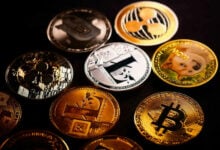NFTs explained – What is it and how does it work

NFTs has been gaining popularity over the past two years. From art and music to Jack Dorsey’s first tweet and toilet paper, these digital assets are selling for up to millions of dollars. In December 2021, an anonymous artist Pak sold 266,445 shares of his NFT Merge for $91.8 million on Nifty Gateway. He is now known as the most expensive living artist in the world.
However, many of you must be thinking right now what the heck is an NFT and how does it work? If you are that person then you have come to the right place so let’s start with the basics.
What exactly is an NFT?
NFT’s, non-fungible tokens are digital asset that represents real-world objects like art, music, in-game items and videos. Non-fungible means that it is unique and irreplaceable. Your cars key, your dog, your child’s drawing displayed proudly on the fridge are non-fungible. It’s the only one that exists on this planet and therefore emotional values are placed on these items making them prestigious.
A fungible object, on the other hand, is something like a dollar that can be substituted with another dollar and still be valued and used for the same reason.
NFTs are part of the Ethereum blockchain and are bought and sold through cryptocurrency. Ethereum is a cryptocurrency like bitcoin.
NFTs are unique files that live on a blockchain. A blockchain keeps track of all transactions and checks the validity of each transaction made.
Many of you may be thinking, yeah so are NFTs really worth the money. Why is there so much hype about it? Well, some experts believe they, like the dotcom craze and Beanie Babies, are about to burst. Others feel that NFTs are here to stay and will permanently change investment.
So what are the benefits of NFT’s?
While the internet has long allowed us to share our digital creations, we’ve never had a way to verify the validity and ownership of those works. Now, thanks to NFTs, we can finally attach incontrovertible proof of creation and ownership to unique digital assets.
NFT allows you to create artificial scarcity so that you can sell something at a higher price due to its limited supply.
Market efficiency is also the most obvious benefit of NFT’s. Converting a physical item to a digital asset simplifies processes and eliminates middlemen. On a blockchain, NFTs represent digital or physical artwork, removing the need for agencies and allowing artists to communicate directly with their consumers.
NFTs are different from traditional investments, such as stocks and bonds. By adding NFTs to an investment portfolio, you could improve its efficiency. Basically, this means achieving a better balance of risk and return.
What are the risks?
Trading NFTs involves technical procedures that are frequently misinterpreted, leaving investors in the dark about what they’re getting into.
Every time you connect with the blockchain, you’ll have to pay a fee to cover the costs of “mining” — the extremely energy-intensive computer operations required to validate each transaction.
Thousands of people may rush to purchase a highly sought-after NFT as soon as it is released, and you must pay the costs even if you walk away empty-handed.
Where can I buy or sell NFTs?
Since NFT’s are bought with cryptocurrency, you will first need a crypto wallet to start. You must convert your money into a digital currency like Ethereum.
Several platforms that allow you to purchase or sell NFT’s include OpenSea, Mintable, SiperRare, Blockee and Rarible. Opensea however has the largest NFT marketplace and connects better to Etherium as compared to other platforms.
Check our article on hotel trends to watch in 2022- Check-in like a VIP
Latest Thailand News
Follow The Thaiger on Google News:


























